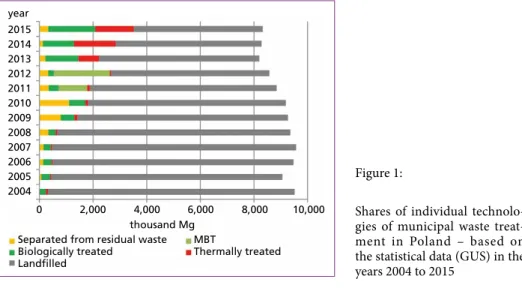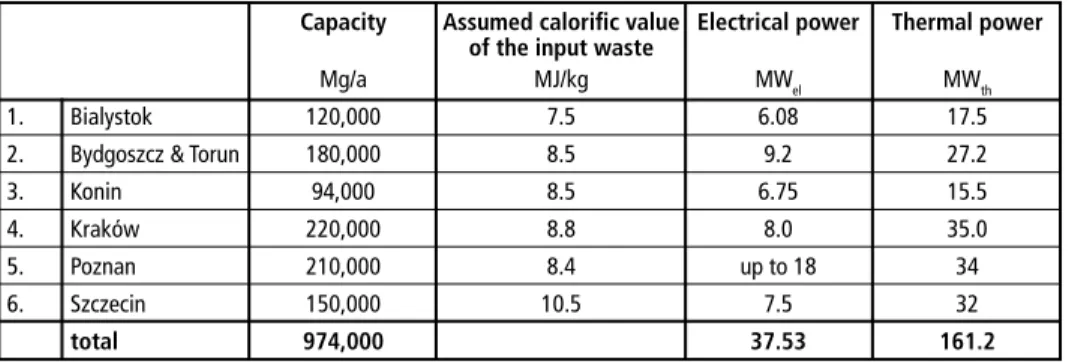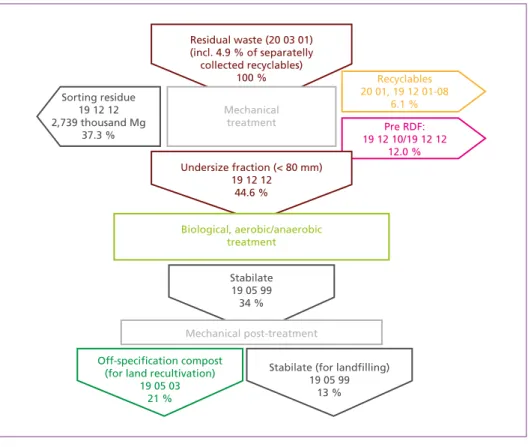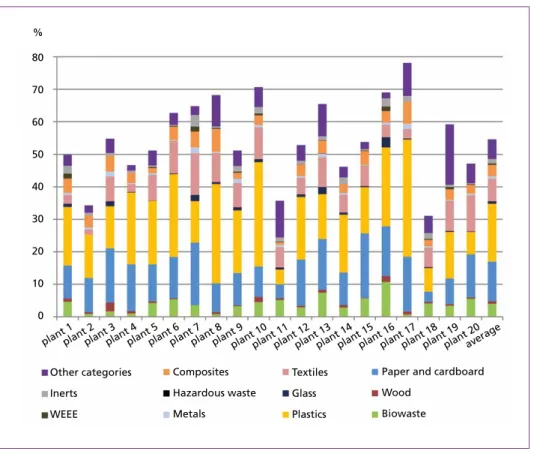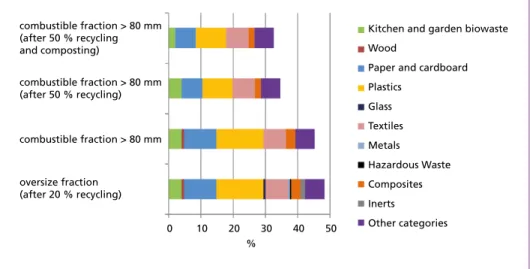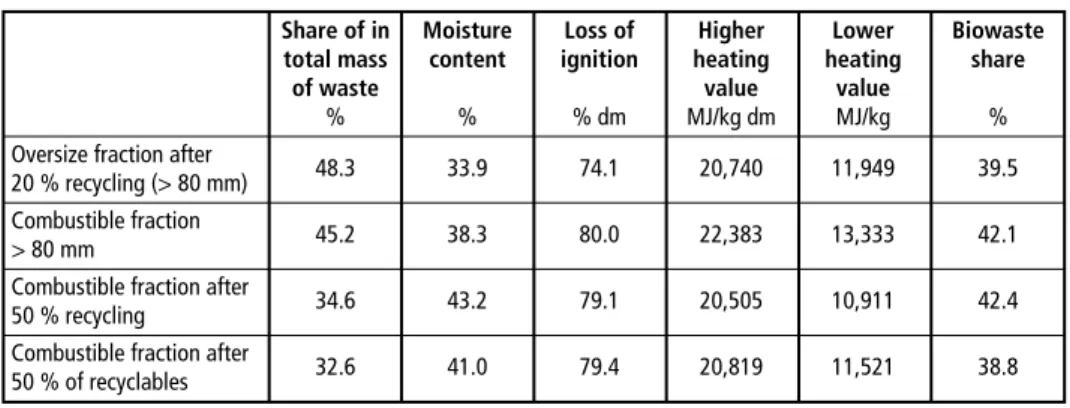MBT and SRF
High Calorific Fraction for Energy Recovery in Poland – an Overview of the Current Situation
Emilia den Boer
1. Legal aspects of waste management in Poland ...302
2. Municipal waste management balance in Poland ...303
3. Residues after mechanical-biological treatment ...304
4. Advanced MBT technology ...306
5. The composition and properties of the oversize fractions of municipal waste ...307
6. Possibilities of using waste fuels of inferior quality ...310
6.1. Increasing the recovery of fuels from municipal waste in cement kilns ...311
6.2. Energy recovery from lower-quality fuels in the energy sector ...311
7. Short-term solution of fuel fraction ...313
8. Summary ...313
9. Literature ...314 Currently, one of the most important challenges of municipal waste management in Poland is the ban on landfilling of the combustible fraction of municipal waste, which entered into force on January 1, 2016. The oversize (> 80 mm) sorting residue from mechanical-biological treatment (MBT) constitutes one of the most important streams, to which the regulation applies. Most of the residual waste in Poland is treated in MBT plants. The mechanically separated oversize fraction can be used to produce the so called refuse derived fuel (RDF), constituting waste classified under code 19 12 10 according to the Waste Catalogue [11]. From 2017 approximately 1.0 million Mg of residual waste should be treated in the Polish waste-to-energy (WtE) plants. Cement kilns fulfil the con- ditions of waste co-incineration. However, only the best quality fuels from waste can be applied in the clinker formation process. The cement kilns co-incinerate approximately 1.0 to 1.4 million Mg of waste fuels, of which RDF from municipal waste is estimated at approximately 0.75 to 1.0 mio Mg. The remaining combustible waste fraction after MBT constitutes approximately 2.4 million Mg. For these lower quality fuels the infra- structure is lacking. This resulted in a significant increase of their disposal costs. In other
MBT and SRF
countries, this fraction has long been used for energy recovery in dedicated installations.
In Poland the majority of installations for the recovery of inferior quality fuels from waste are still in the planning stage. This article presents the quantitative and qualitative characteristics of combustible fraction of municipal waste and discussed the potential for its use.
1. Legal aspects of waste management in Poland
In the recent years the municipal waste management in Poland has undergone dyna- mic changes, with regard to both the waste treatment infrastructure and the system’s organization. From July 2013 municipalities on the basis of the amendment to the Act on cleanliness and order in the municipalities of September 13, 1996 [15] took over the responsibilities related to the organization of municipal waste management. Mu- nicipalities are, among others, responsible for achieving the required recycling and preparation for reuse levels and reduction of the biodegradable waste landfilling. By 2020, 50 % of paper, glass, plastics and metals contained in municipal waste should be recycled. At the same time, landfilling of biodegradable waste should be limited to 35 % of the mass of those wastes generated in 1995. The basis for rational waste management is the selective collection of recyclables and biowaste. Clean, selectively collected frac- tions can be subject to high quality (material or organic) recycling. Levels of selective collection in Poland grow gradually, but still are significantly lower than the required level of recycling in 2020. In 2015, the shares of separate collection amounted to appro- ximately 18 % of paper, 38 % of glass, 23 % of plastics, 8 % of metals, 11 % of textiles and 15 % of biowaste. 8,326 thousand Mg of municipal waste was collected as mixed waste, which is 77 % out of the total municipal waste generated (10,863 thousand Mg) [3].
Due to low separate collection levels and reluctance towards WtE plants – the MBT tech- nology has become a primary method to treat residul municipal waste and reduce the landfilling of biodegradable waste. MBT technology in Poland is also expected to divert materials for recycling. In Poland residual municipal waste must be processed exclusi- vely in the Regional Installations, which accept waste from an area inhabited with at least 120 thousand people [14]. According to the National Waste Management Plan 2022, there are 127 regional MBT plants in operation [13], with a total mechanical processing capacity of 9.4 million Mg per year, and the biological capacity of about 4,1 million Mg per year. Until 2015 there was only one incinerator with a capacity of 60 thousand Mg per year. By now, 6 new WtE plants have been put into operation with a total capacity of 974 thousand Mg per year. The main problem related to MBT technology is that it generates a number of new waste streams which need final disposal. Stabilate, being the product of the biological treatment of the undersized fraction (the so called biofraction) is partially used for land recultivation purposes (within the landfill cover), while the remaining part must be landfilled. In addition, most of MBT plants in Poland yield two streams of combustible waste – 1) preRDF, consisting of materials with the highest ca- lorific value (mainly plastics) directed to the production of fuel for cement plants and 2) the residual fraction, referred to as sorting residue (19 12 12), constituting more than 37 % of the input waste. Until 2016 the latter was commonly landfilled.
MBT and SRF
On January 1, 2016 Annex 4 of the Regu- lation of the Minister of Economy on the acceptance of waste to landfill [5] entered into force. This annex specifies additional criteria for the acceptance of municipal waste, sewage sludge and the sorting resi- dues in a landfill for waste other than ha- zardous and inert [11] (Table 1). Admissible levels of Total Organic Carbon (TOC), Loss of Ignition (LOI) and Higher Heating Value (HHV) exclude the possibility to landfill the sorting residue from MBT plants.
Table 1: Waste acceptance criteria for codes 19 08 05, 19 08 12, 19 08 14, 19 12 and 12 from group 20 for disposal of waste at landfills for other than hazardous and inert waste (OJ 2015 pos. 1277)1
Parameter Admissible limit values
TOC 5 % dm
LOI 8 % dm*
HHV 6 MJ/kg dm
* For waste code 19 08 14 from inorganic chemistry production, admissible LOI value is 30 % dry mass (dm)
Implementation of the requirements of this regulation is currently one of the biggest challenges for municipal waste management in Poland.
2. Municipal waste management balance in Poland
Figure 1 shows the progress of the implementation of the various technologies of muni- cipal waste treatment [3]. Based on the most recent statistical data, 10,863 thousand Mg of municipal waste was collected in Poland in 2015 (Figure 1), out of which 8,326 thousand Mg was collected as residual/mixed waste. In 2015 2,867 thousand Mg of municipal waste was recycled. It means that approximately 8,266 thousand Mg should have been handled in the MBT plants. According to Figure 1, 1439 thousand Mg of waste was thermally treated. Assuming that all the waste that was separately collected was recycled the additional amount of waste recovered for recycling from residual
1 19 08 05 – stabilized municipal sewage sludge; 19 08 12 – Sludge from biological treatment of industrial waste- water; 19 08 14 – sludges from other treatment of industrial wastewater; 19 12 12 – Other waste (including mixtures of materials) from mechanical treatment of wastes other than those listed in 19 12 11
year 2015 2014 2013 2012 2011 2010 2009 2008 2007 2006 2005 2004
0 2,000 4,000 6,000 8,000 10,000
thousand Mg Separated from residual waste Biologically treated
Landfilled
MBT
Thermally treated
Figure 1:
Shares of individual technolo- gies of municipal waste treat- ment in Poland – based on the statistical data (GUS) in the years 2004 to 2015
MBT and SRF
waste must have amounted to approximately 330 thousand Mg, which was sorted out in MBT plants. From another source it is known that approximately 1 million Mg of waste fuels was used for energy recovery in cement kilns. However, due to low quality of fuels from municipal waste they are normally enriched with industrial waste or sorting residues from recyclables. It is assumed that approximately 750 to 850 thousand Mg of RDF was produced from municipal waste [13].
The share of mixed/residual waste directed to thermal treatment increased in 2017.
The total capacity of six new WtE plants is presented in Table 2. All these plants use grate furnace technology, integrated with a boiler.
Table 2: A summary of key design data on the newly constructed WtE plants in Poland Capacity Assumed calorific value Electrical power Thermal power
of the input waste
Mg/a MJ/kg MWel MWth
1. Bialystok 120,000 7.5 6.08 17.5
2. Bydgoszcz & Torun 180,000 8.5 9.2 27.2
3. Konin 94,000 8.5 6.75 15.5
4. Kraków 220,000 8.8 8.0 35.0
5. Poznan 210,000 8.4 up to 18 34
6. Szczecin 150,000 10.5 7.5 32
total 974,000 37.53 161.2
based on data of plant operators and Cyranka, M.; Jurczyk, M.; Pająk, T.: Municipal Waste-to-Energy plants in Poland – current projects, E3S Web of Conferences 10, SEED 00070 (2016), DOI: 10.1051//20161000070
Apart from this a few WtE projects are under way – a plant in Rzeszów (with capacity of approximately 100 thousand Mg per year) and one in Warsaw with the capacity of approximately 265 thousand Mg per year [17]. The national waste management plan (KPGO2022) assumes that the total capacity for municipal waste incineration should not exceed 30 % of all generated waste.
Assuming that the level of collection will continue to increase and that from 2017 residual waste will be first treated in the seven WtE plants, this means that the amount of residual waste processed in MBT plants will decrease to approximately 7,292 thousand Mg per year.
3. Residues after mechanical-biological treatment
In the MBT technology various fractions are separated from residual waste which re- quire further recovery or disposal. The balance of MBT technology can be calculated based on the data obtained from the review of twenty installations in Poland [7]. One of the first processes in MBT is the separation of the undersize fraction (usually sieved on an 80 mm sieve), which is directed to biological stabilization. According to the data obtained, the average share of the undersize fraction is approximately 48.5 % of the residual waste. Given the estimated amount of waste treated in MBT plants in 2017,
MBT and SRF
the undersize fraction of waste < 80 mm, which should be directed to biological stabili- zation accounts for approximately 3,537 thousand Mg. The end product of this process is the so called stabilate, classifies as waste code 19 05 99, which is landfills or can be partly used in land recultivation process. This waste does not need to fulfil the landfill acceptance criteria listed in Table 1.
The total amount of oversize fraction (> 80 mm) is about 3,945 thousand Mg. This fraction contains both materials for recycling, as well as the high calorific fraction that can be used for energy recovery. In the context of expertise [7], the effectiveness of recycling, and recovery of waste fuels in the Polish MBT plants was evaluated.
The average share of recycling in the MBT installations was 6.1 % (range: 0.04 % to 15.0 %), which corresponds to approximately 445 thousand Mg. The average share of separated calorific fraction (preRDF) was 12.0 % (1.7 % to 43.7 %), which corresponds to 875 thousand Mg. This is more or less conform with the amount of RDF from mu- nicipal waste mentioned in KPGO 2022 [13]. The average balance of the treatment plants based on the assessment of 20 MBT installations in Poland [7] is shown in Figure 2.
Residual waste (20 03 01) (incl. 4.9 % of separatelly collected recyclables)
100 % Sorting residue
19 12 12 2,739 thousand Mg
37.3 %
Recyclables 20 01, 19 12 01-08
6.1 % Pre RDF:
19 12 10/19 12 12 12.0 %
Stabilate 19 05 99 34 %
Off-specification compost (for land recultivation)
19 05 03 21 %
Stabilate (for landfilling) 19 05 99
13 % Mechanical
treatment
Mechanical post-treatment Biological, aerobic/anaerobic
treatment Undersize fraction (< 80 mm)
19 12 12 44.6 %
Figure 2: The average balance of MBT, based on 20 installations in Poland MBT
Source: Jędrczak, A.; den Boer, E.: Raport końcowy III etapu ekspertyzy mającej na celu przeprowadzenie badań odpadów w 20 instalacjach do mechaniczno-biologicznego przetwarzania odpadów (Final Report stage III study designed to test 20 plants for mechanical-biological treatment of waste). Zielona Góra, 2015
MBT and SRF
Taking into account the above assumptions, it can be calculated that the remaining fraction of the oversize fraction, which has so far been landfilled amounted to approxi- mately 2.4 million Mg per year. As of January 1, 2016, this fraction has to be recovered or disposed of in a different way than landfilling.
4. Advanced MBT technology
Due to the increasing requirements concerning waste recycling and still quite low level of separate collection in Poland, the role of MBT plants is seen as complementary in achieving the required recycling levels. More and more MBT installations in Poland has been upgraded and equipped with new, more efficient devices for separation of individual material streams. Those MBT plants have been initially designed to treat residual waste stream, however, as the separate collection increases they increasingly process the separately collected recyclables stream. The separation of fractions for recycling is made possible by applying modern technologies, ranging from magnetic separators, Eddy-current separators, optical separators, in which materials are recog- nized based on the specific and unique spectral properties (operating most often in near infrared range). This makes it possible to separate the whole range of plastics, broken into individual polymers (PET, PP, PS, HDPE, foils, etc.), paper, packaging, composite packaging etc.
The study [7] revealed that the degree of separation increase with the increasing number of devices (Figure 3).
Recycling level, as a share of waste delivered to the MBT plant
% 16 14 12 10 8 6 4 2 0
Number of devices in the mechanical part/10,000 Mg
0 1 2 3 4 5 6 7 8
y = 1.3355x + 2.1563 R2 = 0.5224 SianówSwidnica´
Rudna Wielka
Torun´
Nysa KrosnoInowrocław Bydgoszcz
Mysłakowice
Zambrów Trzebania
Gdańsk
Płońsk Orli Staw Siedliska Puławy
Bielsko-Biała Łężyce
Tychy
Lubin
Figure 3: Efficiency of materials separation in selected MBT plants in Poland
Source: Jędrczak, A.; den Boer, E.: Raport końcowy III etapu ekspertyzy mającej na celu przeprowadzenie badań odpadów w 20 instalacjach do mechaniczno-biologicznego przetwarzania odpadów (Final Report stage III study designed to test 20 plants for mechanical-biological treatment of waste). Zielona Góra, 2015
MBT and SRF
The calorific fraction (preRDF) is obtained from the residual fraction, after separa- ting the recyclables. It can be done by an additional optical separator, which selects predefined combustible materials, especially plastics of inferior quality (not suitable for recycling).
Using the optical sorting technology plastics containing elevated levels of chlorine, mainly polyvinyl chloride (PVC), can be separated out of the fuel stream. This, so called preRDF fraction from MBT plants is most often forwarded for further processing in a RDF production plant. However, some of the MBT plants are also equipped with a fuel production line. The basic steps in preparation of fuel from oversize fraction include coarse shredding, separation of non-combustible materials (usually at the air-separa- tors), optionally additional separation of metals and a secondary shredding to particle size of < 30 mm, as required by the cement plants. Depending on the composition and properties of the oversize fraction a share of it remains as the sorting residue. From the analysis of twenty MBT plants it is known that the average share of the MBT sorting residue is 37.3 % of the input residual waste. This fraction was previously landfilled however due to the landfill acceptance criteria it is not possible any more.
5. The composition and properties of the oversize fractions of municipal waste
The oversize fraction in the examined 20 MBT plants constituted on average 54.5 % of the total MBT input, but the range for individual plants was 32.9 % to 74.3 % [7]. Its composition is presented in Figure 4. The presented data refers to waste from various parts of Poland. Analyses were performed in the heating season. Oversize waste fraction contains high share of combustible materials, especially plastics, other categories (mainly waste of disposable diapers), textiles, composite materials, paper and cardboard. The total share of combustible materials in the oversize fraction very high, in the presented data almost 95 % of the oversize fraction, which equals to 51.8 % of the initial weight of residual waste (Figure 4). 6.1 % of the oversize fraction goes to recycling, which means that max. 48.3 % of the total MBT input is available for energy recovery.
Table 3 shows the properties of oversize fraction separated in MBT plants – the average values and respective ranges of values from individual plants. It can be seen that despite high variability, the data clearly shows that combustion properties of these waste are very good. The average LHV is 11,9 MJ/kg. It also provides the expected composition of RDF assuming that it would be produced from the whole > 80 mm fraction.
Data shown in Table 3 clearly shows that the LOI, TOC and the HHV of the oversize fraction exceeds the limit values for the acceptance of this waste in landfills (set at 8 % dm, 5 % dm and 6 MJ/kg dm, respectively).
Figure 5 shows the composition of oversize fraction which will be available for energy recovery. The share of oversize fraction after separation of 6.1 % of recyclables (20 % recy- cling level, including separately collected fractions in 2017) is 48.3 %, referred to the total mass of residual waste entering MBT plants (in 2017 approximately 7,292 thousand Mg).
MBT and SRF
Thus in 2017 the estimated amount of oversize residue is 3,520 thousand Mg. Table 4 presents the properties of oversize fraction available for energy recovery. Average mois- ture content of this the oversize fraction is approximately 33.9 %, and the lower heating value would amount to approximately 11,949 kJ/kg. It contains however some of inert fractions, which need to be separated. The combustible fraction of it is approximately 3,300 thousand Mg (45.2 % of the MBT input), with the LHV 13,333 kJ/kg.
% 80 70 60 50 40 30 20 10 0
Other categories Inerts
WEEE
Composites Hazardous waste Metals
Textiles Glass Plastics
Paper and cardboard Wood
Biowaste plant
1 plant
2 plant
3 plant
4 plant
5 plant
6 plant
7 plant
8 plant
9
plant 10plant 11plant 12plant 13plant 14plant 15plant 16plant 17plant 18plant 19plant 20averag e
Figure 4: Composition of oversize fraction (mostly > 80 mm) separated from residual waste
based on: Jędrczak, A.; den Boer, E.: Raport końcowy III etapu ekspertyzy mającej na celu przeprowadzenie badań odpadów w 20 instalacjach do mechaniczno-biologicznego przetwarzania odpadów (Final Report stage III study designed to test 20 plants for mechanical-biological treatment of waste). Zielona Góra, 2015
Unit Range of values Average value Share of biodegradables 25.4 – 56.8 39.5 Moisture % 14.7 – 46.0 33.9
LOI % dm 59.5 – 89.1 74.1
TOC % dm 33.3 – 51.5 41.8
HHV MJ/kg dm 17.5 – 25.0 20.7 Source: Jędrczak, A.; den Boer, E.: Raport końcowy III etapu ekspertyzy mającej na celu przeprowadzenie badań odpadów w 20 instalacjach do mechaniczno- biologicznego przetwarzania odpadów (Final Report stage III study designed to test 20 plants for mechanical-biological treatment of waste). Zielona Góra 2015
Table 3:
Average parameters of the oversize fraction
MBT and SRF
At present, only 12 % (related to the MBT input) of high quality RDF is separated out of the oversize (> 80 mm) fraction of residual waste (875 thousand Mg for energy recovery in cement kilns). It can be expected that the amount of this inferior quality fuels will be approximately 2,424 thousand Mg per year. Given that the current share of RDF fulfils the requirements of cement kilns (LHV > 20 MJ/kg), it can be expected that the remaining combustible fraction will have a LHV in the range of 11 to 11,5 MJ/kg.
The amount and composition of RDF from residual waste will change over time, due to increase of recycling (concerning especially plastics, paper or composite pa- ckaging). This is due to the obligation to divert 50 % of recyclables from municipal waste to material recycling already in 2020 (in 2017 only 20 % recycling is obligatory in Po- land). In Figure 5, the third bar shows the quantity and composition of the combustible fraction after diverting for recycling an additional 35 % of plastics, paper and composites from the analysed waste (the total amount of recycled materials, taking into account the level of separate collection would in this case will amount to approximately 50 % of recyclables). The share of the combustible fraction in this case will be 32.6 % of the total waste (2,525 thousand Mg) and its moisture content will increase to 43.2 %. This will reduce the lower heating value as shown in the Table 4 to 10,911 kJ/kg. The next fraction that will have to be collected selectively in the future is biowaste (kitchen and garden waste). Biowaste is predominantly contained in the < 80 mm fraction of residual waste, but to a lesser extent also in the analysed fuel fraction. Targeting organic recycling of 50 % of biowaste contained in the fuel fraction would reduce the moisture content of this fraction to 41.0 %, which causes an increase of the calorific value to 11,521 kJ/kg.
In this case, the amount of fuel fraction would be about 32.6 % of the present amount of residual waste (approximately 2,377 thousand Mg).
combustible fraction > 80 mm (after 50 % recycling and composting)
combustible fraction > 80 mm (after 50 % recycling)
combustible fraction > 80 mm
oversize fraction (after 20 % recycling)
0 10 20 30 40 50
%
Kitchen and garden biowaste Wood
Paper and cardboard Plastics
Glass Textiles Metals
Hazardous Waste Composites Inerts
Other categories
Figure 5: Changes of composition of oversize fraction after separation of recyclables and biowaste
based on: Jędrczak, A.; den Boer, E.: Raport końcowy III etapu ekspertyzy mającej na celu przeprowadzenie badań odpadów w 20 instalacjach do mechaniczno-biologicznego przetwarzania odpadów (Final Report stage III study designed to test 20 plants for mechanical-biological treatment of waste). Zielona Góra, 2015
MBT and SRF
Over time, after the increase of the separate collection of recyclables, the remaining quantity of fuel fraction will be approximately 2,525 thousand Mg per year. After intro- ducing separate collection of biowaste, it could be further reduced to approximately 2,377 thousand Mg of fuels per year. On the other hand, the proposal to amend the Landfill Directive [10] in the framework of the so-called circular economy package assumes the reduction of the share of landfilled waste to 10 % of the total weight of municipal waste in 2030. The meaning of it is that we need also to gradually limit the disposal of the undersized fraction subjected to the biological stabilization in MBP installations, which currently accounts for 48.5 % of the weight of residual waste directed to MBT plants. Only a small part of this fraction can be used for land reclamation, due to its low quality. This fraction also contains combustible waste that will have to be recovered.
6. Possibilities of using waste fuels of inferior quality
The possibilities of using RDF of inferior quality are very limited in Poland. In general, the activities that can be carried out to reduce the landfilling of combustible fractions include:
The long-term, desired measures, such as:
• increasing the level of selective collection for recycling so that the quantity of resi- dual waste for fuel will be reduced at source;
• use as an alternative energy source in industry (especially in cement industry and power industry);
and the ad hoc solutions to solve the actual problems:
• temporary storage of combustible waste fractions (for a max. 3 years period before the recovery operations);
• export of lower quality RDF to other countries – mainly Germany and Sweden (inef- ficient and expensive solution, due to high costs of transport and waste acceptance).
Table 4: Fuel properties of fraction > 80 mm of residual waste after separation of non-combustibles, recyclables and biowaste
Share of in Moisture Loss of Higher Lower Biowaste
total mass content ignition heating heating share
of waste value value
% % % dm MJ/kg dm MJ/kg %
Oversize fraction after
20 % recycling (> 80 mm) 48.3 33.9 74.1 20,740 11,949 39.5 Combustible fraction
> 80 mm 45.2 38.3 80.0 22,383 13,333 42.1
Combustible fraction after
50 % recycling 34.6 43.2 79.1 20,505 10,911 42.4
Combustible fraction after
50 % of recyclables 32.6 41.0 79.4 20,819 11,521 38.8 based on own research
MBT and SRF
6.1. Increasing the recovery of fuels from municipal waste in cement kilns
Incineration and co-incineration of RDF must meet process requirements, which are significantly more stringent than for conventional fuels. The potential investors in WtE technology require stable policy and acceptable market conditions. The RDF market in Poland lacked it and by now it had to compete with a relatively cheap alternative in form of landfilling. Consequently, in Poland the only established recipients of RDF are cement kilns. Due to the long residence of the exhaust gas in high temperatures, highly alkaline environment and the lack of solid residues, cement kilns without major modifications fulfil the requirements co-incineration of RDF. Fuel replace here the conventional source of energy, without any negative impact on the process, which fur- thermore reduces production costs. Cement kilns have however, well-defined and relatively high requirements in relation to from waste, which can be met only by the highest quality RDF from municipal waste. Exemplary RDF quality requirements by Cemex Poland are provided below [1] :
• calorific value of over 17 MJ/kg by supplying to the precalciner, and above 20 MJ/kg by supplying to the main by the main burner,
• water content < 20 %,
• chlorine content of < 0.7 %,
• sulphur content < 1 %,
• total heavy metals < 2,000 ppm.
In order to comply with the above requirements a deep sorting of residual waste is required in order to separate only materials with the highest LHV and low moisture content (mainly plastics). The other options is additional drying. Cement plants are able to receive up to 1.5 million Mg of waste fuels, however in order to maintain high quality, the RDF from municipal waste is enriched with high quality industrial fuels. It is estimated that 750 thousand Mg are fuels from municipal waste [13] while the remai- ning stream comes from industry. Increasing the share of RDF from municipal waste in cement kilns has only marginal meaning. This would require drying of these fuels in order to reduce their moisture content.
6.2. Energy recovery from lower-quality fuels in the energy sector
The only rational solution for lower quality fuels is energy recovery in specialised WtE plants producing power and heat, which are widely applied in other countries, such as among others Germany and the Scandinavian countries. Generally, the conditions for the implementation of the energy recovery from inferior quality fuels in Poland are favourable [8]:
• there are approximately 20 thousand km heat distribution networks;
• approximately 42 % of the heat needs is covered from the network;
• installed thermal power is approximately 58 thousand MW (heat);
MBT and SRF
• 50 % of plant sources are less than 50 MW;
• currently used fuel is coal in approximately 75 %;
• there is a heat demand throughout the year (warm water).
Several energy companies are considering the use of waste fuels. An example is the thermal power provider in Wałbrzych (PEC), which began the preparatory work for the investment using RDF. The proposed power unit is a steam boiler furnace with a stepped hearth and one drum, with natural circulation and a nominal capacity of 15 t/h (11.6 MW) [8]. The boiler is designed for 26,529 Mg per year of alternative fuel (19 12 10) (3,400 kg/h), with a calorific value of 14 to 16 MJ/kg. The efficiency of heat production is approximately 50 %, while the electricity approximately 36 %.
Multi-fuel boiler (coal/biomass/RDF) with installed power of 76 MWel/127 MWth is under construction in Zabrze. Construction of waste to energy plants using RDF is also planned in several other locations. In Olsztyn there is a plan to install a capacity of approximately 100 thousand Mg per year. In Gdańsk it is planned to build RDF plant which would utilise 150 thousand Mg per year fuel produced by six MBT plants in the region. At the same time the national waste management plan sets at maximum permissible volume waste to energy plants at 30 % of the total mass of municipal waste.
In total approximately 0.6 % of primary energy demand could be replaced by RDF from municipal waste. Waste to energy plants of RDF are fully justified in the waste hierarchy and from the point of view of environmental protection. Moreover, they would solve the current problem of overproduction of RDF by the MBT plants.
The discussion on the possible use of waste fuels in the energy sector has lasted for years. So far, however, the instability of law (lack of control over the municipal waste stream, shifting the ban on landfilling of the calorific fraction in time), as well as the fluctuations of the RDF stream (varying availability, quality and prices) were perceived as a barrier in the development of waste to energy plants. Currently, however, there are good market conditions to develop WtE as long-term solution for energy recovery form this waste fractions. In addition to the ban on landfilling, there is already a number of regulations to, which promote the energy use of waste fuels, including:
• possibility to classify the portion of the chemical energy contained in fuels of waste (biodegradable fraction) as biomass – energy from renewable source [16],
• current need of modernization of existing power plants (need to replace old boilers), including exhaust gas cleaning facilities due to the tightening of emission standards of air pollutants [6, 12],
• the possibility of obtaining additional benefits for the reduction of CO2 emissions during co-combustion of waste (biodegradable fraction) and participation in the system of emissions trading.
Capacity of waste to energy plants for a given region recovery should be adapted to the demand in the region – the amount of fuels from waste and the presence of other systems which would enable the preparation of fuels from waste of the required quality.
MBT and SRF
7. Short-term solution of fuel fraction
The consequence of the lack of technology for the energy recovery of caloric fractions (19 12 12) is increase of prices for their reception. These prices increased from 120 to 130 zł/Mg net to 175 to 180 zł/Mg [2]. Currently, waste fuels are stored in many plants. This is associated with a high risk – especially the formation of fires, as well as the offsetting of the actual problem in time. In addition, some plants solve the prob- lem by directing more of the residual waste to a biological stabilization. The landfill acceptance criteria do not cover the stabilate at the moment. This solution is unfavo- urable due to the increasing stream being landfilled, opposed to the initially intended effect. Currently, the landfill tax for stabilate fulfilling the biological stability criterion (expressing the respiration activity within 4 days of incubation – AT4 < 10 mg O2/g dm) is 24.15 zł/Mg. The new Regulation on environmental fees of March 2017 [9] provides for a significant increase in the landfill tax of stabilate that will not meet the additional two parameters – LOI of less than 35 % dm and TOC of less than 20 % dry matter.
Fees for landfilling of stabilate which does not meet these requirements will rise to 140 zł/Mg in 2018, 170 zł/Mg in the 2019 and 270 zł/Mg in 2020. If these parameters are met, the landfill fee shall be multiplied by 0.25. Landfilling of sorting residues (19 12 12) will also be subject to an increased fee, as above. In this case there is no reduction potential. Such a high fee for the landfilling of the sorting residua constitutes a significant motivation to invest in alternative methods of its use.
8. Summary
The ban on landfilling of waste with a HHV > 6 MJ/kg dm is a very big challenge for waste management in Poland. Although more than 10 years it was known that this provision will finally come into force, no investments were realized to secure the pos- sibility of utilising this stream.
Taking into account the extension of the thermal treatment capacity for residual waste (6 incinerations since 2016) and that the remaining residual waste will go to the MBT plants, assuming the current recovery of recyclables and high quality waste fuels (0.875 million Mg per year), the remaining oversize fraction (> 80 mm) amounts to 2.6 million Mg per year of which the combustible fraction constitutes about 2.4 million Mg per year.
The lower heating value of this fraction amounts to approximately 11.0 to 11.5 MJ/
kg. However, full implementation of the 2020 recycling target (50 % of paper, plastics, glass and metals and 50 % of biowaste) will result in decreasing the total stream for energy recovery from MBT outputs to approximately 2.5 million Mg per year (with LHV of approximately 11 Mj/kg). An additional collection of 50 % of biowaste will cause further reduction to 2.4 million Mg (LHV 11.5 MJ/kg). Waste to energy infra- structure for this fraction is lacking, however the newly implemented high landfill charges provides an additional incentive for investments.
MBT and SRF
9. Literature
[1] Bąblewski, P. 2012. Co-combustion of alternative fuels in cement Cemex Poland, CEMEX Po- land, Warsaw 2012 (available at: http://powermeetings.eu/konferencje/prezentacje/IPAL_14- 06-2012/CEMEX.pdf)
[2] Błachowicz, K. Odpady kaloryczne – coraz bardziej palący problem (Calorific waste - ever more pressing problem), Revision Communal 10/2016
[3] Central Statistical Office (GUS) Environmental Protection in 2016
[4] Cyranka, M.; Jurczyk, M.; Pająk, T.: Municipal Waste-to-Energy plants in Poland – current projects, E3S Web of Conferences 10, SEED 00070 (2016), DOI: 10.1051//20161000070 [5] Decree of the Minister of Economy of 16 July 2015. On the acceptance of waste to landfill
(OJ 2015 pos. 1277)
[6] Environmental Protection Law (2001 Journal No. 62 pos. 627)
[7] Jędrczak, A.; den Boer, E.: Raport końcowy III etapu ekspertyzy mającej na celu przeprowadze- nie badań odpadów w 20 instalacjach do mechaniczno-biologicznego przetwarzania odpadów (Final Report stage III study designed to test 20 plants for mechanical-biological treatment of waste). Zielona Góra,s 2015
[8] Kruczkowski, P. The potential use of alternative fuels RDF municipal waste – the concept of the construction of a cogeneration unit PEC SA Walbrzych. VIII conference Mechanical Biological Treatment, Abrys, May 11-13, 2015., Proteins-Tatrzańska[11] Regulation of the Minister of the Environment of 9 December 2014. On waste, OJ 2014 item. 1923
[9] Ministry of the Environment. Regulation amending the Regulation on fees for using the envi- ronment of 6 March 2016 (OJ 2017 poz. 723)
[10] Proposal for a Directive of the European Parliament and of the Council Amending Directive 1999 /31 /EC on the landfill of waste COM /2015/0594 final; 2015/0274 (COD)
[11] Regulation of the Minister of the Environment of 9 December 2014. On waste, OJ 2014 item.
1923
[12] Regulation of the Minister of the Environment of 4 November 2014. On emission standards from installations (Journal of Laws 2014, item. 1546)
[13] Resolution No. 88 of the Council of Ministers on 1 July 2016. On the National Waste Management Plan 2022, 2016-08-11, Polish Monitor, 2016 Pos: 784
[14] The Act of 14 December 2012. On waste. OJ 2013 item. 21
[15] The act of maintaining clearness and order in communities (OJ OJ 1996 132 pos. 622) [16] The Minister of Environment of 8 June 2016. On the technical conditions of qualifying a part of
energy recovered from thermal treatment of waste (OJ 2016. Pos. 847)
[17] Wielgosiński, G., Namiecińska, O. Spalarnie odpadów komunalnych – perspektywa roku 2020 (Waste incineration - Perspective of 2020), New Energy; 2/2016
Bibliografische Information der Deutschen Nationalbibliothek Die Deutsche Nationalbibliothek verzeichnet diese Publikation in der Deutschen Nationalbibliografie; detaillierte bibliografische Daten sind im Internet über http://dnb.dnb.de abrufbar
Thomé-Kozmiensky, K. J.; Thiel, S.; Thomé-Kozmiensky, E.;
Winter, F.; Juchelková, D. (Eds.): Waste Management, Volume 7 – Waste-to-Energy – ISBN 978-3-944310-37-4 TK Verlag Karl Thomé-Kozmiensky
Copyright: Elisabeth Thomé-Kozmiensky, M.Sc., Dr.-Ing. Stephanie Thiel All rights reserved
Publisher: TK Verlag Karl Thomé-Kozmiensky • Neuruppin 2017
Editorial office: Dr.-Ing. Stephanie Thiel, Elisabeth Thomé-Kozmiensky, M. Sc.
Janin Burbott-Seidel and Claudia Naumann-Deppe
Layout: Sandra Peters, Anne Kuhlo, Ginette Teske, Claudia Naumann-Deppe, Janin Burbott-Seidel, Gabi Spiegel and Cordula Müller
Printing: Universal Medien GmbH, Munich
This work is protected by copyright. The rights founded by this, particularly those of translation, reprinting, lecturing, extraction of illustrations and tables, broadcasting, micro- filming or reproduction by other means and storing in a retrieval system, remain reserved, even for exploitation only of excerpts. Reproduction of this work or of part of this work, also in individual cases, is only permissible within the limits of the legal provisions of the copyright law of the Federal Republic of Germany from 9 September 1965 in the currently valid revision. There is a fundamental duty to pay for this. Infringements are subject to the penal provisions of the copyright law.
The repeating of commonly used names, trade names, goods descriptions etc. in this work does not permit, even without specific mention, the assumption that such names are to be considered free under the terms of the law concerning goods descriptions and trade mark protection and can thus be used by anyone.
Should reference be made in this work, directly or indirectly, to laws, regulations or guide- lines, e.g. DIN, VDI, VDE, VGB, or these are quoted from, then the publisher cannot ac- cept any guarantee for correctness, completeness or currency. It is recommended to refer to the complete regulations or guidelines in their currently valid versions if required for ones own work.
